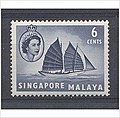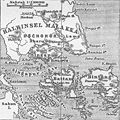Portal:Singapore
 Map of Singapore Singapore, officially the Republic of Singapore, is an island country and city-state in Southeast Asia. The country's territory comprises one main island, 63 satellite islands and islets, and one outlying islet. It is about one degree of latitude (137 kilometres or 85 miles) north of the equator, off the southern tip of the Malay Peninsula, bordering the Strait of Malacca to the west, the Singapore Strait to the south along with the Riau Islands in Indonesia, the South China Sea to the east, and the Straits of Johor along with the State of Johor in Malaysia to the north.
Singapore's history dates back at least eight hundred years, having been a maritime emporium known as Temasek and subsequently a major constituent part of several successive thalassocratic empires. Its contemporary era began in 1819, when Stamford Raffles established Singapore as an entrepôt trading post of the British Empire. In 1867, Singapore came under the direct control of Britain as part of the Straits Settlements. During World War II, Singapore was occupied by Japan in 1942 and returned to British control as a separate Crown colony following Japan's surrender in 1945. Singapore gained self-governance in 1959 and, in 1963, became part of the new federation of Malaysia, alongside Malaya, North Borneo, and Sarawak. Ideological differences led to Singapore's expulsion from the federation two years later; Singapore became an independent sovereign country in 1965. After early years of turbulence and despite lacking natural resources and a hinterland, the nation rapidly developed to become one of the Four Asian Tigers. As a highly developed country, it has one of the highest GDP per capita (PPP) in the world. It is also identified as a tax haven. Singapore is the only country in Asia with a AAA sovereign credit rating from all major rating agencies. It is a major aviation, financial, and maritime shipping hub and has consistently been ranked as one of the most expensive cities to live in for expatriates and foreign workers. Singapore ranks highly in key social indicators: education, healthcare, quality of life, personal safety, infrastructure, and housing, with a home-ownership rate of 88 percent. Singaporeans enjoy one of the longest life expectancies, fastest Internet connection speeds, lowest infant mortality rates, and lowest levels of corruption in the world. It has the third highest population density of any country in the world, although there are numerous green and recreational spaces as a result of urban planning. With a multicultural population and in recognition of the cultural identities of the major ethnic groups within the nation, Singapore has four official languages: English, Malay, Mandarin, and Tamil. English is the common language, with exclusive use in numerous public services. Multi-racialism is enshrined in the constitution and continues to shape national policies in education, housing, and politics. Singapore is a parliamentary republic in the Westminster tradition of unicameral parliamentary government, and its legal system is based on common law. While the country is de jure a multi-party democracy with free elections, the government under the People's Action Party (PAP) wields widespread control and political dominance. The PAP has governed the country continuously since full internal self-government was achieved in 1959, and holds a supermajority in Parliament. One of the five founding members of ASEAN, Singapore is also the headquarters of the Asia-Pacific Economic Cooperation Secretariat, the Pacific Economic Cooperation Council Secretariat, and is the host city of many international conferences and events. Singapore is also a member of the United Nations, the World Trade Organization, the East Asia Summit, the Non-Aligned Movement, and the Commonwealth of Nations. (Full article...)Selected article -Tropical Storm Vamei (also known as Typhoon Vamei) was a Pacific tropical cyclone that formed at about 85 nautical miles (100 mi; 160 km) from the equator—closer than any other tropical cyclone on record. The last storm of the 2001 Pacific typhoon season, Vamei developed on 26 December at 1.4° N in the South China Sea. It strengthened quickly and made landfall along extreme southeastern Peninsular Malaysia. Vamei rapidly weakened into a remnant low over Sumatra on 28 December, and the remnants eventually re-organized in the North Indian Ocean. Afterward, the storm encountered strong wind shear once again, and dissipated on 1 January 2002. Though Vamei was officially designated as a tropical storm, its intensity is disputed; some agencies classify it as a typhoon, based on sustained winds of 120 km/h (75 mph) and the appearance of an eye. The storm brought flooding and landslides to eastern Peninsular Malaysia, causing $3.58 million in damage (2001 USD, $6.16 million 2024 USD) and five deaths. (Full article...) Selected picturePhotograph credit: Chensiyuan The Singapore National Day Parade is a national ceremony in Singapore that takes place each year on 9 August to commemorate the country's independence. The firework display seen here was part of the festivities in 2011, held at The Float @ Marina Bay, the world's largest floating stage and football stadium, located on the waters of the Marina Reservoir. In the foreground on the right is the lotus-flower-shaped ArtScience Museum, situated within Marina Bay Sands, an integrated resort that opened in the same year.
General imagesThe following are images from various Singapore-related articles on Wikipedia.
Selected biography -Han Sai Por (Chinese: 韓少芙; born 19 July 1943) is a Singaporean sculptor. A graduate of the Nanyang Academy of Fine Arts (NAFA), East Ham College of Art, Wolverhampton College of Art (now the School of Art and Design of the University of Wolverhampton), and Lincoln University, New Zealand, she worked as a teacher and later as a part-time lecturer at NAFA, the LASALLE-SIA College of the Arts, and the National Institute of Education, Nanyang Technological University, before becoming a full-time artist in 1997. Han has participated in exhibitions locally and abroad, including events in China, Denmark, Japan, Malaysia, New Zealand, and South Korea. Her first solo exhibition, entitled Four Dimensions, was held at the National Museum Art Gallery in 1993. Her sculptures can be found around the world, in Osaka and Shōdoshima, Kagawa Prefecture, in Japan; Kuala Lumpur and Sarawak in Malaysia; and Washington, D.C., in Singapore, sculptures commissioned from her can be seen at Capital Tower, the Defence Science Organisation National Laboratories, the Esplanade – Theatres on the Bay, the National Museum of Singapore, Revenue House, Singapore Changi Airport Terminal 3, Suntec City Mall, and Woodlands Regional Library. In 2001, Han was the founding President of the Sculpture Society (Singapore) and remains its Honorary President. She was the first artist in residence at the Society's Sculpture Pavilion at Fort Canning Park in 2009, where she worked on sculptures made from the trunks of tembusu trees. (Full article...) Did you know (auto-generated)
In this month
More did you know -
Selected panoramaThe Changi Beach Park (Chinese: 樟宜海滨公园) is a beach park located at the northeastern tip of Singapore. The 28-hectare Changi Beach Park is one of the oldest coastal parks in Singapore. The park is 3.2 km long with stretches of sandy beaches between Changi Point and Changi Ferry Road. Singapore topicsRelated portalsSoutheast Asia Other Countries Tasks
CategoriesWikiprojectsAssociated WikimediaThe following Wikimedia Foundation sister projects provide more on this subject:
Discover Wikipedia using portals |

































































